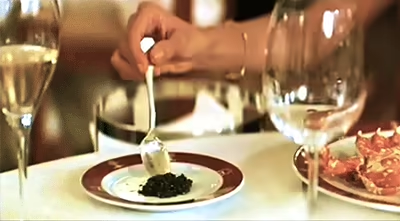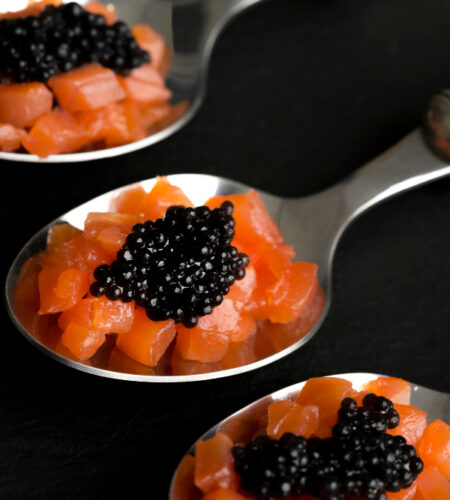Have you ever wondered what caviar actually is? Often seen at fancy gatherings and gourmet food shops, caviar is considered a real treat. Is it just fish eggs? In this blog post, we’ll explore what caviar is, where it comes from, and why it’s so special.
What Exactly is Caviar?
Defining Caviar: Is Caviar Fish Eggs ?
Caviar isn’t just any fish eggs; it’s specifically the roe from sturgeon fish. This delicacy is prized for its unique, salty flavor and its pop-in-your-mouth texture.
The most common types of sturgeon that provide this fancy treat are Beluga, Ossetra, and Sevruga. So, when you hear someone asking, “Is caviar fish eggs?”—the answer is yes, but only from specific types of fish.
How Caviar Became a Delicacy
Caviar has a rich history dating back to ancient times when it was first eaten by Persian fishermen. It was considered a luxury even back then because of its rarity and unique flavor. Over the centuries, its status as a top-tier delicacy has only grown, making it a symbol of wealth and sophistication.
How is Caviar Made?
Caviar is harvested from sturgeon when the fish are ready to spawn. The eggs are carefully removed, washed, and lightly salted to enhance their flavor and preserve them.
This process, known as “curing,” is crucial because it affects the final taste and quality of the caviar. Only the best techniques and precise handling produce high-quality caviar that meets the expectations of gourmet food lovers.
Types of Caviar and Their Differences

From Beluga to Sevruga: Exploring Varieties
When you ask, “Is caviar fish eggs?” it’s like asking if all apples are the same. Just like apples, caviar comes in different types that vary in taste, color, and size. Let’s break it down simply:
- Beluga Caviar: Known for its large, soft eggs that are usually light grey. It’s very creamy and has a delicate flavor.
- Ossetra Caviar: These eggs are medium-sized and can range in color from golden to dark brown. It has a nutty, rich flavor that many love.
- Sevruga Caviar: The eggs here are smaller and usually darker. It packs a strong, salty punch, which is perfect for those who like bold tastes.
Each type of caviar offers a unique experience, so trying different kinds can be a lot of fun. Think of it like tasting different types of chocolate until you find your favorite!
Nutritional Value of Caviar
Is Caviar Good for You?
Caviar isn’t just a treat for your taste buds; it’s also packed with good stuff for your body. Here’s why you might consider adding a little bit of caviar to your diet:
- Rich in Omega-3s: These fats are great for your heart and help keep your brain sharp.
- Full of Vitamin B12: Just a small amount of caviar can give you a big chunk of the daily recommended intake of B12, which is important for your nerves and blood cells.
- Has Selenium: This is a mineral that helps your immune system stay strong.
So, is caviar good for you? Yes, in small amounts, it can be a healthy choice. Just remember, it does have a lot of salt, so it’s best to enjoy it now and then, not every day.
Best Practices for Serving and Eating Caviar
Wondering how to enjoy caviar the right way? Here are some simple tips to help you get the most out of this fancy treat:
- Keep It Cool: Serve caviar cold. It’s best straight from the fridge, as the cool temperature brings out its unique taste.
- Use the Right Tools: Always use a non-metallic spoon, like one made from plastic, glass, or mother of pearl. Metal spoons can change the flavor of caviar, and you don’t want that!
- Simple Pairings Work Best: Caviar doesn’t need much dressing up. Try it on a small blini or toast point with a dab of crème fraîche. This keeps the focus on the caviar’s flavor.
- Drink Pairing: A glass of chilled vodka or dry champagne pairs beautifully with caviar. The crispness complements the caviar’s saltiness.
- Portion Size: A little goes a long way. A spoonful per person is usually enough to enjoy the experience without overwhelming your taste buds.
Remember, caviar is a special experience. Whether you’re celebrating a big event or just treating yourself, these tips will make sure you enjoy every bit of its luxurious flavor. Just keep it simple and let the quality of the caviar shine through. Enjoy your treat!
Conclusion
Now that you know caviar is indeed fish eggs—but only from specific types of sturgeon—and you understand what makes it a prized delicacy, why not try some at your next celebration? Remember, whether it’s a treat for a special occasion or a luxurious snack, caviar brings a touch of elegance to any gathering.
FAQs about Caviar
Real caviar is specifically harvested from sturgeon, which are ancient fish that have been around for millions of years. The most prized caviar comes from Beluga, Ossetra, and Sevruga sturgeons.
Absolutely! The most well-known types are Beluga, Ossetra, and Sevruga. Each one varies in size, color, and taste. Beluga caviar is large and mild, Ossetra is nutty, and Sevruga offers a more intense flavor.
Caviar’s high price is due to the slow growth and late maturity of sturgeon, making the harvesting process lengthy and their roe rare. Plus, the meticulous care needed to process caviar adds to its luxury status.
No, only sturgeon roe is considered true caviar. Roe from other fish must be specifically labeled, like salmon roe or trout roe, and it’s not the same as caviar in terms of flavor and texture.
To keep caviar fresh, store it in the coldest part of your refrigerator, usually at the back, tightly sealed. It’s best enjoyed within a few days of opening to maintain its delicate flavor and quality.
Read More: How Long Does It Take for Flea Eggs to Hatch

